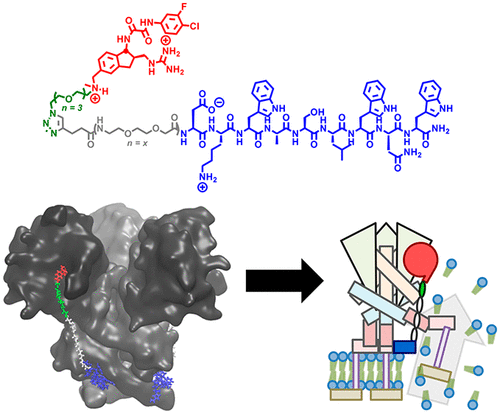当前位置:
X-MOL 学术
›
ACS Chem. Biol.
›
论文详情
Our official English website, www.x-mol.net, welcomes your feedback! (Note: you will need to create a separate account there.)
HIV-1 Env-Dependent Cell Killing by Bifunctional Small-Molecule/Peptide Conjugates
ACS Chemical Biology ( IF 4 ) Pub Date : 2021-01-07 , DOI: 10.1021/acschembio.0c00888 Althea Gaffney 1 , Aakansha Nangarlia 2, 3 , Charles G Ang 2 , Steven Gossert 4 , Adel Ahmed Rashad Ahmed 2 , Md Alamgir Hossain 2 , Cameron F Abrams 4 , Amos B Smith 1 , Irwin Chaiken 2
ACS Chemical Biology ( IF 4 ) Pub Date : 2021-01-07 , DOI: 10.1021/acschembio.0c00888 Althea Gaffney 1 , Aakansha Nangarlia 2, 3 , Charles G Ang 2 , Steven Gossert 4 , Adel Ahmed Rashad Ahmed 2 , Md Alamgir Hossain 2 , Cameron F Abrams 4 , Amos B Smith 1 , Irwin Chaiken 2
Affiliation

|
A strategy has been established for the synthesis of a family of bifunctional HIV-1 inhibitor covalent conjugates with the potential to bind simultaneously to both the gp120 and gp41 subunits of the HIV-1 envelope glycoprotein trimeric complex (Env). One component of the conjugates is derived from BNM-III-170, a small-molecule CD4 mimic that binds to gp120. The second component, comprised of the peptide DKWASLWNW (“Trp3”), was derived from the N-terminus of the HIV-1 gp41 Membrane Proximal External Region (MPER) and found previously to bind to the gp41 subunit of Env. The resulting bifunctional conjugates were shown to inhibit virus cell infection with low micromolar potency and to induce lysis of the HIV-1 virion. Crucially, virolysis was found to be dependent on the covalent linkage of the BNM-III-170 and Trp3 domains, as coadministration of a mixture of the un-cross-linked components proved to be nonlytic. However, a significant magnitude of lytic activity was observed in Env-negative and other control pseudoviruses, suggesting parallel mechanisms of action of the conjugates involving Env interaction and direct membrane disruption. Computational modeling suggested strong membrane-binding activity of BNM-III-170, which may underly the nonspecific virolytic effects of the conjugates. To investigate the scope of the membrane effect, cell-based cytotoxicity and membrane permeability assays were performed employing flow cytometry. Here, we observed a dose-dependent and specific cytotoxic effect on HIV-1 Env-expressing cells by the small-molecule bifunctional inhibitor. Most importantly, Env-negative cells were not susceptible to the cytotoxic effect upon exposure to this construct at concentrations where cell-killing effects were observed for Env-positive cells. Computational structural modeling supports a mechanism in which the bifunctional inhibitors bind to the gp120 and gp41 subunits in tandem in open-state Env trimers and induce relative motion of the gp120 subunits consistent with models of Env inactivation. This observation supports the idea that the cell-killing effect of the small-molecule bifunctional inhibitor is due to specific Env conformational triggering. This work lays important groundwork to advance a small-molecule bifunctional inhibitor approach for eliminating Env-expressing infected cells and the eradication of HIV-1.
中文翻译:

双功能小分子/肽结合物对HIV-1 Env依赖性细胞的杀伤作用
已经建立了合成双功能HIV-1抑制剂共价缀合物家族的策略,该家族具有同时与HIV-1包膜糖蛋白三聚体复合体(Env)的gp120和gp41亚基结合的潜力。结合物的一种成分来自BNM-III-170,BNM-III-170是一种与gp120结合的小分子CD4模拟物。由肽DKWASLWNW(“ Trp3”)组成的第二种成分衍生自HIV-1 gp41膜近端外部区域(MPER)的N端,先前发现与Env的gp41亚基结合。所得的双功能结合物显示出以低微摩尔效价抑制病毒细胞感染并诱导HIV-1病毒体的裂解。至关重要的是,发现病毒分解取决于BNM-III-170和Trp3域的共价键,因为未交联组分的混合物的共同给药被证明是不溶的。但是,在Env阴性和其他对照假病毒中观察到了很大的裂解活性,表明结合物的平行作用机制涉及Env相互作用和直接膜破坏。计算模型表明,BNM-III-170具有很强的膜结合活性,这可能是结合物的非特异性溶血作用。为了研究膜效应的范围,采用流式细胞仪进行了基于细胞的细胞毒性和膜通透性测定。在这里,我们观察到小分子双功能抑制剂对HIV-1 Env表达细胞的剂量依赖性和特异性细胞毒性作用。最重要的是,Env阴性细胞在暴露于该构建体的浓度下对细胞毒性作用不敏感,该浓度可观察到Env阳性细胞具有杀伤作用。计算结构建模支持一种机制,其中双功能抑制剂在开放状态Env三聚体中串联结合到gp120和gp41亚基,并诱导与Env灭活模型一致的gp120亚基的相对运动。该观察结果支持小分子双功能抑制剂的细胞杀伤作用是由于特定的Env构象触发所致。这项工作为推进小分子双功能抑制剂方法的发展奠定了重要基础,该方法可消除表达Env的感染细胞并消除HIV-1。
更新日期:2021-01-15
中文翻译:

双功能小分子/肽结合物对HIV-1 Env依赖性细胞的杀伤作用
已经建立了合成双功能HIV-1抑制剂共价缀合物家族的策略,该家族具有同时与HIV-1包膜糖蛋白三聚体复合体(Env)的gp120和gp41亚基结合的潜力。结合物的一种成分来自BNM-III-170,BNM-III-170是一种与gp120结合的小分子CD4模拟物。由肽DKWASLWNW(“ Trp3”)组成的第二种成分衍生自HIV-1 gp41膜近端外部区域(MPER)的N端,先前发现与Env的gp41亚基结合。所得的双功能结合物显示出以低微摩尔效价抑制病毒细胞感染并诱导HIV-1病毒体的裂解。至关重要的是,发现病毒分解取决于BNM-III-170和Trp3域的共价键,因为未交联组分的混合物的共同给药被证明是不溶的。但是,在Env阴性和其他对照假病毒中观察到了很大的裂解活性,表明结合物的平行作用机制涉及Env相互作用和直接膜破坏。计算模型表明,BNM-III-170具有很强的膜结合活性,这可能是结合物的非特异性溶血作用。为了研究膜效应的范围,采用流式细胞仪进行了基于细胞的细胞毒性和膜通透性测定。在这里,我们观察到小分子双功能抑制剂对HIV-1 Env表达细胞的剂量依赖性和特异性细胞毒性作用。最重要的是,Env阴性细胞在暴露于该构建体的浓度下对细胞毒性作用不敏感,该浓度可观察到Env阳性细胞具有杀伤作用。计算结构建模支持一种机制,其中双功能抑制剂在开放状态Env三聚体中串联结合到gp120和gp41亚基,并诱导与Env灭活模型一致的gp120亚基的相对运动。该观察结果支持小分子双功能抑制剂的细胞杀伤作用是由于特定的Env构象触发所致。这项工作为推进小分子双功能抑制剂方法的发展奠定了重要基础,该方法可消除表达Env的感染细胞并消除HIV-1。


























 京公网安备 11010802027423号
京公网安备 11010802027423号